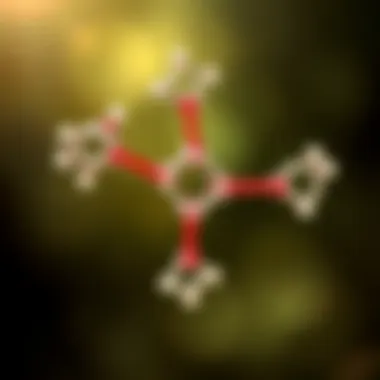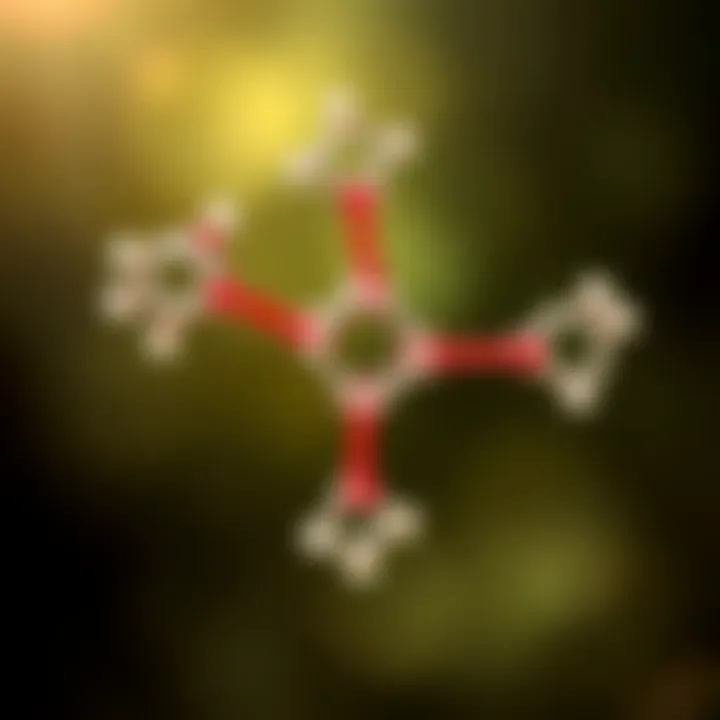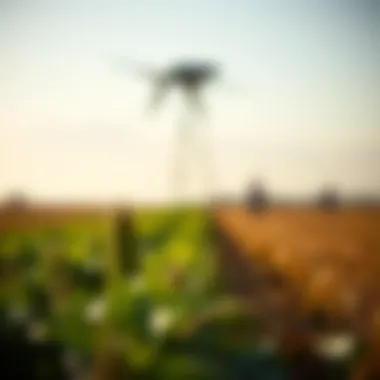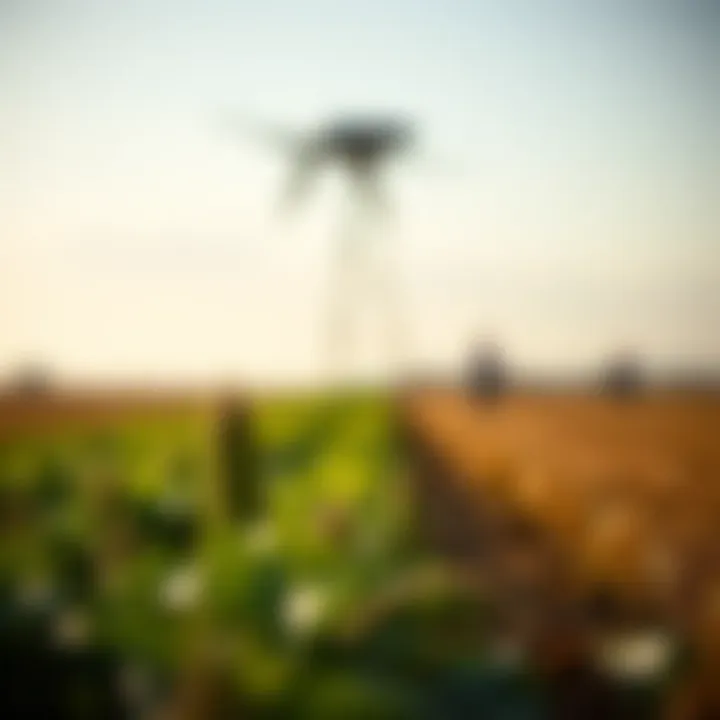Triclosan: Uses, Risks, and Sustainable Alternatives


Intro
Triclosan, an antimicrobial compound that has become a staple in many consumer products, is deserving of scrutiny due to its wide-ranging implications in various sectors, particularly agriculture and personal care. While this chemical has been praised for its effectiveness against bacteria, its effects on health and the environment have raised considerable questions among scientists, regulators, and consumers alike. The burgeoning awareness about antibiotic resistance and potential toxicity associated with triclosan sheds light on the urgent need for alternative approaches.
Understanding the uses and impacts of triclosan is not just a matter of scientific inquiry but also a question of responsibility towards sustainable practices and public health. As we dive deeper into this topic, we'll dissect the mechanisms behind its application, its historical significance, the challenges presented by its use, and the emerging solutions to mitigate its impact. This exploration is vital for agriculture farmers and enthusiasts, who not only apply these substances in their operations but also contribute to the larger discourse on environmental stewardship and health safety.
In this journey through the intricacies of triclosan, we will uncover key definitions, trace its historical pathway, investigate contemporary trends, and review practical applications, thereby illuminating a path forward in the discussion surrounding this ubiquitous chemical.
Preface to Triclosan
Triclosan has been a common name whispered in the halls of both healthcare and agriculture. Understanding its role within these sectors is not just a passing fancy; it has consequences that ripple through our health and the environment. As we explore the applications and impacts of triclosan, we illuminate its role as an antimicrobial agent, while also navigating the murky waters of its implications. The stakes are high; with the rise of antibiotic resistance and the looming threat of environmental degradation, understanding triclosan’s broader context becomes crucial for informed decision-making.
The importance of this topic is underscored by the sheer volume of products containing triclosan, reaching from hand soaps to agricultural pesticides. The widespread use signals not only its effectiveness but also highlights the complexity surrounding its safety and sustainability.
Here we take a closer look at triclosan, peeling back the layers to understand its chemical makeup, mechanism of action, and the numerous debates that swirl around its use.
Definition and Chemical Structure
Triclosan, chemically known as 2,4,4'-trichloro-2'-hydroxydiphenyl ether, is quite the mouthful. But at its core, it is designed to combat bacteria. The compound boasts a unique molecular structure, which consists of two aromatic rings linked by an ether bond. This structure not only contributes to its efficacy but also raises some red flags regarding its persistence in the environment.
- Chemical Formula: C12H7Cl3O
- Molar Mass: 289.54 g/mol
This chemical configuration allows triclosan to disrupt bacterial cell membranes, a feature that has previously landed it in many personal care products. Interestingly, the chlorinated elements are what raise concerns as they can bioaccumulate in various ecosystems.
"Triclosan's stability in the environment suggests that it can linger longer than desired, making it a subject of scrutiny for environmentalists and health professionals alike."
As we immerse deeper into the article, we will dissect these chemical characteristics and their far-reaching implications on both human health and ecological systems.
Historical Context of Triclosan Use
The historical context of triclosan provides crucial insights into how its role has evolved over the years, particularly within agricultural and consumer spheres. Understanding the timeline of triclosan’s introduction and its subsequent adoption allows us to appreciate the broader themes of innovation, regulatory response, and changing public perception surrounding this chemical. In essence, this exploration unveils the journey of triclosan from its development to its prominent position in various products today.
Development and Commercialization
Triclosan, first synthesized in the early 1960s, was initially developed as a surgical scrub agent. Its commercialization began soon after, when the pharmaceutical company Ciba-Geigy recognized the compound's promising antimicrobial properties. Although the motivation behind its creation targeted the healthcare sector, the discovery of its effectiveness in combatting a range of bacteria and fungi soon led to its broader application in consumer goods. By the late 1970s, triclosan had made its way into toothpaste and soaps and was heralded as a revolutionary way to enhance hygiene. However, the rapid commercialization also sowed the seeds of controversy.
As its presence in everyday products grew, so did concerns regarding its safety and environmental impact. In particular, the rise of antibiotic resistance and its correlation with widespread use became a significant topic of discussion among scientists and public health officials. This backdrop of increasing scrutiny has continuously shaped the regulatory landscape, compelling manufacturers to reassess their use of this chemical in consumer items.
Initial Applications in Consumer Products
From the get-go, triclosan found usage in personal care products like soaps and deodorants, praised for its ability to eliminate germs effectively and prolong freshness. However, it didn’t stop there. Manufacturers quickly tapped into triclosan's antifungal capabilities, integrating it into items such as dishwashing liquids, laundry detergents, and even household cleaning products. This multifaceted application led consumers to perceive such goods as superior and safer, bolstering sales across various sectors.
Here are some notable characteristics of initial triclosan applications:
- Antimicrobial Effectiveness: Valuable in creating personal hygiene products that claimed to kill 99.9% of germs.
- Consumer Trust: Enhanced marketing strategies positioned products containing triclosan as essential for maintaining health, thus feeding consumer trust.
- Widespread Adoption: Quickly became a household name, featuring in products spanning cosmetics to industrial sanitation.
“Triclosan’s versatility meant it became ubiquitous in both homes and healthcare settings, reflecting a broader societal trend toward sterility and cleanliness.”
However, as consumer awareness grew, so did the questioning of its overuse and potential risks. Each stage of triclosan's journey reveals the intricate balancing act between innovation and responsibility as society grapples with the consequences of its past actions.
In sum, the historical context of triclosan is not merely a timeline; it is a rich tapestry showing the evolution of technologies, perceptions, and the ongoing dialogues about health and safety. Addressing the roots of triclosan's adoption provides a clear lens through which we can examine its current applications and implications in today’s world.
Mechanism of Action
Understanding the mechanism of action of triclosan is pivotal for grasping its multifaceted applications and implications in both agricultural and health contexts. By delving into how this compound interacts with microbial organisms, one can appreciate its role either as a useful tool or a contentious player in the arena of public health and environmental safety.
How Triclosan Functions as an Antimicrobial Agent
Triclosan is primarily recognized for its antimicrobial properties, which stem from its ability to disrupt the function of enzymes that are crucial for bacterial fatty acid synthesis. This interference effectively inhibits the bacteria's ability to produce components necessary for their cellular membrane, leading to cell death. When triclosan comes into contact with bacteria, it binds to the active site of the enzyme enoyl-ACP reductase, which is integral in the production of fatty acids. This ultimately stops the growth of bacteria and reduces bacterial counts, which is why it has been a chosen agent in a variety of consumer and medical products.
- Key Properties of Triclosan:
- Broad-spectrum antimicrobial efficacy
- Stability in various formulations
- Ability to reduce bacterial resistance when used appropriately
However, the effectiveness of triclosan can be compromised in an overly sanitized environment, as continuous exposure may lead to selective pressure, permitting resistant strains to survive and thrive.
Impact on Bacterial Cells
The impact that triclosan has on bacterial cells can be viewed through a two-fold lens of effectiveness and risk. It aggressively targets bacterial cells, yet its prolonged use has ignited substantial debate in scientific and agricultural circles regarding antibiotic resistance.
When triclosan is applied effectively, it can drastically lower bacterial populations, which is beneficial for health-related uses. Healthcare settings like hospitals utilize products containing triclosan to maintain sterility within environments prone to infection.
However, the flip side is concerning. As bacteria are subjected repeatedly to triclosan, some may develop resistance mechanisms, potentially leading to what the scientific community describes as a “public health threat.” This is particularly pertinent for farmers who rely on triclosan in agricultural contexts, where the emergence of resistant strains could hinder crop yields or lead to more severe outbreaks of infection.
In essence, while the effectiveness of triclosan as an antimicrobial agent cannot be easily dismissed, one must remain vigilant about its long-term consequences on both microbial ecology and public health. The balance between leveraging its benefits while mitigating risks associated with antibiotic resistance remains a crucial discussion.
"The use of triclosan underscores the complex interplay between human innovation and nature's adaptive capacities. A delicate tightrope indeed."
To further understand its impact, examining detailed studies on specific strains of bacteria that exhibit resistance can provide clarity. More research is needed to tailor the applications of triclosan in ways that maximize benefits without exacerbating the problem of resistance.


Applications of Triclosan
Triclosan finds itself straddling the worlds of medicine and agriculture, showcasing its versatility and the multifaceted ways it is utilized. This section delves into its applications, particularly emphasizing how it functions in medical products and its burgeoning role in agriculture. Understanding these aspects helps elucidate both the benefits and the underlying concerns associated with this chemical. By exploring these applications, we can better grasp its significance in our daily lives and its potential implications for public health and safety.
Medical and Health Care Products
In the realm of health care, triclosan has been a staple in various products aimed at reducing infections and promoting hygiene. Commonly found in hand sanitizers, soaps, and toothpaste, this chemical serves a crucial role as an antimicrobial agent. Its primary function is to eradicate harmful bacteria and fungi, making it invaluable in settings where cleanliness is paramount.
The widespread incorporation of triclosan into consumer products stems from its efficacy. It is particularly effective against bacteria like Staphylococcus aureus and Escherichia coli, which can lead to severe infections if not properly managed. Moreover, in a world increasingly concerned with health risks, products infused with triclosan provide a sense of security, ensuring that germs are kept at bay.
However, the integration of triclosan into medical products is not without complexity.
- Potential Side Effects: There are rising concerns about the potential for skin irritations or sensitivities in some users, as overuse might lead to adverse reactions.
- Bacterial Resistance: Continuous exposure could also contribute to antibiotic resistance, complicating treatment for bacterial infections in the long run.
Hence, while the advantages of triclosan in health care are notable, they require careful consideration of long-term consequences.
"Triclosan's role in cleanliness is often championed, yet it conceals the intricate balance between efficacy and the risk of resistance, urging for thoughtful usage and alternatives."
Agricultural Uses
Turning to agriculture, triclosan has made its mark in pest control, serving as a biocidal agent in various treatments aimed at safeguarding crops. Its ability to combat bacteria, fungi, and other harmful microorganisms makes it an appealing option for farmers striving for high yields and healthy produce. Functioning as a preservative in agricultural products, it helps to minimize spoilage and enhance the longevity of crops during transport.
The applications of triclosan in agriculture encompass:
- Pest Management: Farmers apply it in formulations to protect crops from diseases that could decimate harvests, ensuring both quality and quantity remain intact.
- Soil Treatments: It can also be involved in soil treatments to prevent fungal growth, thereby fostering a healthier environment for plants to thrive.
However, this use comes with baggage related to environmental and health concerns. The downside to using triclosan in agricultural settings includes:
- Runoff Issues: Triclosan can leach into waterways, potentially affecting aquatic ecosystems and influencing the aquatic life balance.
- Public Scrutiny: As awareness grows regarding chemical usage in farming, products containing triclosan face increasing scrutiny from consumers advocating for more natural alternatives.
Thus, while triclosan serves critical functions in agriculture, the pressing need for sustainable alternatives is undeniable in light of its environmental implications. The contradictions inherent in its use challenge farmers to balance efficacy and environmental stewardship.
Environmental Impact
The discussion around triclosan is incomplete without tackling its environmental impact. Understanding how this chemical behaves in our ecosystem is essential for comprehending its full implications. Triclosan's persistent presence in the environment raises concerns about long-term ecological health, making this a critical point of focus in the analysis.
Persistence in Environment
Triclosan is notorious for being a stubborn compound when introduced into various terrains. Once it makes its way into soil and water, it doesn’t break down easily. This persistence can be attributed to its chemical structure, which resists biodegradation. Researchers have found that in some environments, triclosan can linger for years, accumulating alongside other pollutants and exacerbating their effects.
- Soil Contamination: When used in agricultural contexts, triclosan can find its way into soil, altering microbial communities crucial for nutrient cycling. This disrupts the balance of soil ecosystems, which in turn affects plant health and crop yields.
- Water Contamination: Wastewater treatment plants often struggle to effectively filter out triclosan. As a result, it can contaminate aquatic systems, leading to a ripple effect throughout the food web.
Effects on Aquatic Ecosystems
The presence of triclosan in aquatic ecosystems poses significant hazards. Once it enters rivers and lakes, it can affect aquatic life in several detrimental ways.
- Toxicity to Aquatic Organisms: Numerous studies indicate that triclosan is toxic to a variety of aquatic organisms, including fish and invertebrates. Research has shown changes in behavior, reproduction, and growth in these creatures, which can lead to declining populations.
- Ecosystem Imbalances: The toxicity also extends to non-target organisms, leading to a shift in species dominance. Key species might decline, while those that can withstand the chemical’s effects may proliferate, disturbing the natural equilibrium.
- Bioaccumulation: Because triclosan bioaccumulates in the tissues of aquatic organisms, higher concentrations can be found in predators at the top of the food chain, including humans. This raises concerns about food safety and biodiversity.
***"Triclosan's resistance to degradation is worrying. It’s not just our water and soil quality at stake; it’s the very fabric of our ecosystems that’s being woven with its thread."
The persistent nature of triclosan and its capacity to disrupt aquatic ecosystems underscores the need for mindful usage, particularly in agricultural practices. By critiquing its environmental ramifications, we can shape future regulations and promote healthier practices.
Engagement with these complex dynamics is essential for sustaining not just agricultural productivity, but also the overall health of our environment. Only by understanding these intricate relationships can farmers and stakeholders work toward more sustainable solutions accessible through further research and innovative practices.
Human Health Concerns
The discussion around triclosan isn't just a matter of scientific scrutiny; it taps into something fundamentally vital for everyone—human health. Health concerns relating to triclosan have sparked debates in recent years, especially given its widespread use in various consumer products. Understanding these implications is crucial as we navigate the balancing act between antimicrobial efficacy and potential health risks.
Potential Hormonal Effects
One significant area of concern is the potential hormonal effects of triclosan. Evidence suggests that triclosan may interfere with endocrine functions. Studies have shown that it can inhibit thyroid hormone activity, which is pivotal for regulating metabolism and development.
In the realm of agriculture, where this chemical is often employed, the repercussions may be more extensive. If crops treated with triclosan can indirectly affect human health through dietary consumption, we need to acknowledge that the ripples of such complications extend far beyond just personal care products.
Additionally, its ability to mimic estrogens raises alarms concerning reproductive health issues, particularly among sensitive demographics such as pregnant women and children. This warrants serious consideration, especially when waste from agricultural runoff may lead to increased triclosan exposure through the water supply.
Studies on Allergies and Skin Sensitivities
The skin, being the body's first line of defense, is often the site of interaction with triclosan-laden products. A growing body of research points toward allergies and skin sensitivities. Many consumers have reported experiencing adverse skin reactions after using triclosan-containing items, such as soaps or hand sanitizers. These reactions range from mild irritations to more severe allergic dermatitides, indicating that triclosan may be doing more harm than good in some instances.
Interestingly, the connection between triclosan exposure and the prevalence of allergies, especially in children, has gained traction. Some studies suggest that exposure to triclosan may actually contribute to the development of asthma and other allergic conditions. Consequently, this raises questions about the net benefit we gain from using a product designed to kill germs. Is it worth risking a potential increase in allergies and sensitivities?
In summary, the health concerns surrounding triclosan are multifaceted, emphasizing the need to reevaluate its role in consumer products and agriculture. Keeping a critical eye on the potential hormonal effects and allergy links is essential as we seek to make informed decisions that foster both health and safety in agricultural practices and everyday uses.
"As we delve deeper into the implications of the substances we use, it becomes increasingly clear that scientific advancements must be tempered with caution to safeguard public health."
For more insights on the potential health implications of triclosan, see related resources at CDC and NIH for scientific findings related to endocrine disruptors.
Regulatory Landscape
The regulatory landscape surrounding triclosan is a critical aspect of understanding its role and implications in both consumer products and agricultural applications. As concerns grow over the chemical's potential health risks and environmental impact, various governing bodies have been compelled to establish regulations that seek to manage its use effectively. This regulatory scrutiny not only addresses public health and safety but also reflects broader societal values regarding sustainability and responsible chemical management.


Global Regulations Governing Triclosan
Different countries have adopted varied approaches to regulate triclosan. In the United States, the Environmental Protection Agency (EPA) classifies triclosan as a pesticide due to its antimicrobial properties. This classification necessitates rigorous testing and approval processes before it can be used in consumer products.
Conversely, the European Union has taken a more precautionary stance. Following a thorough assessment of triclosan's safety, the European Chemicals Agency has restricted its use in certain applications, particularly in cosmetics and personal care products. These measures aim to prevent potential hazards associated with triclosan, such as endocrine disruption and its contribution to antibiotic resistance.
In Japan, regulations have also tightened around the use of triclosan in agricultural products. The government has established limits on acceptable residues in food products to mitigate risks to consumers.
"The regulations evolve, reflecting our growing understanding of the impacts chemicals have on health and the environment," notes a recent report by the World Health Organization.
Impact of Regulatory Changes on the Market
The shifting regulatory environment has had significant ramifications on the market dynamics surrounding triclosan. As regulatory frameworks become stricter, manufacturers are often pushed to reformulate their products or seek alternative solutions. This shift has led to the emergence of a market for triclosan-free products, driven by consumer demand for safer and more environmentally-friendly options.
Businesses adapting to these regulations may find themselves at an advantage, particularly in sectors where consumers are increasingly aware of chemical ingredients.
Some key impacts include:
- Increased Production Costs: Manufacturers may face higher costs due to the need for research and development of safer alternatives.
- Market Opportunities: Companies creating innovative, triclosan-free products may capture a segment of the market that prioritizes safety and sustainability.
- Shift in Consumer Preferences: Growing awareness and concern regarding health risks associated with certain chemicals have led consumers to seek transparency in product labeling, influencing purchasing decisions.
Triclosan and Antibiotic Resistance
Antibiotic resistance stands as a growing concern in both public health and agricultural practices. Understanding the implications of triclosan, a widely used antimicrobial agent, is crucial to addressing this issue. As farmers and agricultural enthusiasts navigate a landscape increasingly fraught with resistant bacterial strains, the connection between triclosan and antibiotic resistance deserves deep exploration. This section delves into how triclosan influences the development of resistance mechanisms and draws upon case studies to illustrate real-world implications.
Mechanisms of Resistance Development
The relationship between triclosan and antibiotic resistance hinges on several molecular mechanisms. While triclosan effectively acts against a variety of bacterial strains, the continuous and widespread use of this compound has led some bacteria to adapt. This adaptation often occurs via natural selection, where minimal exposure to triclosan enables susceptible bacteria to perish, leaving behind a resilient population equipped with mechanisms to withstand the antimicrobial effects.
Some of the specific mechanisms include:
- Efflux Pumps: Bacteria may develop efflux pumps, which actively transport triclosan out of the cell, reducing its efficacy. This tactic allows bacteria to survive in environments where the antimicrobial is present.
- Target Modification: Changes in the target sites, primarily the fatty acid synthesis pathways affected by triclosan, can result in decreased binding affinity, allowing bacteria to thrive despite the presence of the antimicrobial.
- Gene Acquisition: Horizontal gene transfer can introduce resistance genes from one bacterial species to another. This can occur through plasmids, which are small DNA molecules that can replicate independently of chromosomal DNA, potentially hosting resistance traits.
These mechanisms aid in the survival and propagation of resistant bacteria, raising alarm bells among scientists and public health officials alike.
Case Studies and Research Findings
Multiple studies have emerged illustrating the real-world effects of triclosan on bacterial resistance, particularly in agricultural settings. For example, one study conducted in the United Kingdom assessed various agricultural soils treated with triclosan-containing products. The results were eye-opening; researchers found a significant increase in the prevalence of resistant bacterial strains that coincided with the usage patterns of triclosan.
Another noteworthy study published by Antimicrobial Agents and Chemotherapy showed frequent occurrences of triclosan resistance genes in clinical isolates of Escherichia coli. The evidence presented suggested that the routine application of triclosan in personal care products may inadvertently bolster resistance that can translate into agricultural bacteria.
Additionally, a research initiative led by a collaborative group of universities in the United States provided insights into the correlation between triclosan use in livestock farming and antibiotic resistance. The study indicated that livestock frequently exposed to triclosan exhibited higher rates of infection with antibiotic-resistant bacteria, leading to increased challenges in treatment options for both animal health and, consequently, human health.
"The unrestrained use of antimicrobial agents like triclosan not only mitigates immediate bacterial threats but also fosters an environment where adaptation undermines the benefits they offer."
Overall, these findings present a pressing need for responsible use and potential reevaluation of triclosan in applications that may impact human health and the health of livestock. Recognizing these mechanisms and outcomes is essential for strategizing against antibiotic resistance rates and promoting sustainable agricultural practices.
Alternatives to Triclosan
The discussion surrounding triclosan touches not just on its widespread use but also the urgent need to find suitable alternatives. As concerns about its impact on health and the environment grow, exploring these alternatives becomes increasingly important. This section outlines various promising substitutes that can fulfill the antimicrobial role of triclosan while aligning more closely with sustainable practices.
Natural Antimicrobials
Natural antimicrobials offer a plethora of options that are increasingly gaining traction in both consumer products and farming. Derived from plants, herbs, and other botanical sources, these substances often possess inherent properties to combat bacteria, fungi, and viruses. Some prominent examples include:
- Essential Oils: Extracts from plants such as tea tree, oregano, and eucalyptus. Studies point to their effectiveness against a range of pathogens, making them suitable in both medical and agricultural applications. For example, tea tree oil is known for its antiseptic properties and is often utilized in personal care formulations.
- Garlic Extract: Not just a kitchen staple, garlic has demonstrated potent antimicrobial effects. Its active compound, allicin, inhibits the growth of certain bacteria and fungi, hence becoming more popular in organic farming practices.
- Honey: Particularly manuka honey, has been shown to have antibacterial properties that are used for wound care and food preservation. Its ability to maintain a natural pH also ensures that it can be effective without harmful side effects.
"Natural alternatives can reduce reliance on synthetic agents like triclosan, promoting a healthier ecosystem for future generations."
Moreover, these natural antimicrobials are often biodegradable, which significantly reduces environmental impact compared to synthetic substances. However, it's essential to evaluate their efficacy, as not all natural products have consistent results.
Innovative Solutions in Agriculture
In wishing for sustainable agricultural practices, innovative solutions that do not consist of harmful chemicals are on the rise.
- Biofungicides: These are derived from natural organisms, and they can combat fungal pathogens while promoting soil health. For instance, Trichoderma spp. can protect crops from diseases while enhancing root growth.
- Plant-Based Biopesticides: Implementing plant extracts as pest deterrents, like neem oil derived from the neem tree, showcases an innovative approach that protects crops without resorting to harmful pesticides. Neem oil disrupts insect growth and development, ultimately reducing pest populations effectively.
- Integrated Pest Management (IPM): This holistic approach combines biological, cultural, and mechanical controls with chemical methods, if necessary. Farmers adopting IPM minimize the need for triclosan-type chemicals, as they utilize ecological balance to keep pests in check.
The beauty of exploring these alternatives lies in their dual benefit: they pave the way for agricultural resilience while meeting consumer demand for safer products. As farmers and producers gear up for a greener future, embracing these innovative practices can fundamentally change the landscape of agriculture.
Research is underway, and collaboration among scientists, farmers, and policymakers can ensure these innovations reach their potential. The movement towards alternatives to triclosan is not just a trend; it’s a pivotal shift in the way we think about health, ecology, and industry.
Public Perception and Consumer Behavior
Understanding public perception and consumer behavior regarding triclosan is pivotal to grasping its overall impact in both agricultural and consumer contexts. The conversation surrounding triclosan is not just confined to its chemical efficacy but also spills over into how individuals and communities react to its presence in everyday products. Mindful consumers who do their homework are increasingly skeptical of ingredients in their products, particularly those that have raised health and environmental concerns. This skepticism shapes purchasing decisions and influences manufacturers’ practices and marketing strategies.
Trends in Consumer Awareness
Consumer awareness about triclosan has evolved significantly over the years. With the rise of the internet and social media, information spreads faster than wildfire. People are no longer just passive consumers; they actively seek knowledge about the products they use. For instance, many individuals now recognize that triclosan was once touted as a miracle antimicrobial agent, but it has come under scrutiny due to potential health risks and environmental effects. This awareness is often fueled by:
- Media Reporting: Articles and news reports about triclosan’s impact have heightened concerns over its use in products like soaps, hand sanitizers, and even toys.
- Scientific Research: Studies highlighting risks related to hormonal disruptions, antibiotic resistance, and environmental persistence have captured public attention, prompting consumers to reconsider their choices.
- Online Platforms: Community discussions on platforms such as Reddit and consumer advocacy groups amplify voices concerned about this compound, contributing to a growing movement for transparency.


It's becoming commonplace for consumers to check product ingredients and opt for alternatives that are marketed as "triclosan-free". This reflects a broader trend towards healthful living and eco-friendliness.
Impact of Labeling and Marketing
Product labeling and marketing play critical roles in influencing consumer behavior. Labels that emphasize the absence of triclosan or highlight natural ingredients catch the eye of those wary of synthetic chemicals. For example, an organic soap brand might proudly display "No Triclosan" on its packaging, which can sway purchasing decisions for health-conscious buyers. On another note, greenwashing presents a challenge too: some brands may claim to be environmentally friendly without meaningful or verifiable commitments, leading to confusion among consumers.
Additionally, the development of regulatory frameworks around labeling has created a significant impact on consumer trust. More stringent labeling laws compel manufacturers to disclose their ingredients, instilling a sense of accountability.
"Transparency in labeling fosters trust; consumers demand clearer communication about what goes into the products they purchase."
Ultimately, as the demand for clarity grows, many companies are adjusting their marketing strategies to emphasize safety and ecological responsibility. Those who ignore this shift risk being left behind in a marketplace increasingly dictated by informed consumers.
Global Trends in Triclosan Use
The subject of global trends in triclosan use is crucial in understanding the comprehensive narrative around this widely discussed antimicrobial agent. Its applications range from personal care products to agricultural endeavors, and tracking these trends offers insights into consumer behavior, regulatory decisions, and public health implications. With rising awareness regarding environmental and health risks associated with triclosan, there has been a noticeable shift in its acceptance and usage across the globe.
Regional Variations in Legislation
Legislation relating to triclosan usage does not share a uniform face globally; it fluctuates significantly from one region to another. For instance, in the European Union, triclosan is tightly regulated due to its potential risks, including environmental hazards and impacts on human health. Regulations dictate that certain limits are set on triclosan concentrations in consumer products to mitigate these risks. Contrastingly, in parts of the United States, there has been a gradual easing of bans around its use in certain products, but heightened scrutiny remains in place.
In Asia, countries such as Japan have seen gradual moves toward reducing reliance on triclosan-based products, promoting cleaner and safer alternatives. This discord in legislation raises questions about the underlying factors influencing such decisions, including public opinion, scientific studies, and environmental lobbying.
"Different countries take varied approaches to the regulation of triclosan, showcasing how cultural and social contexts shape policy decisions."
Market Trends and Predictions
Given the shifting sands of consumer expectations and regulatory measures, the market outlook for triclosan is complex. A growing number of consumers are opting for triclosan-free products, reflecting an increasing trend toward natural and eco-friendly alternatives. This sentiment has led many manufacturers to reformulate their products, seeking innovative solutions to appeal to the environmentally conscious buyer.
Furthermore, as research around triclosan's potential links to antibiotic resistance gains traction, companies in agriculture and personal care sectors may face mounting pressure to pivot away from traditional formulations. Some suggest that, by the year 2030, a significant percentage of triclosan-containing products will become obsolete, with cleaner ingredients taking their place.
Anticipating these shifts, businesses are urged to adapt quickly—embracing sustainability not just as a buzzword but as a core value.
- Emergence of new product lines that focus on:
- Market predictions highlight an expected growth in sectors that prioritize health-safe and eco-friendly alternatives, with a forecasted increase in sales for non-triclosan products by approximately 20% over the next five years.
- Natural antimicrobials.
- Organic farming practices.
- Enhanced consumer education.
The trajectory indicates a competitive landscape where consumers demand transparency and safety, pushing companies to innovate or risk losing market share. As the world becomes more aware of the risks associated with certain chemicals, businesses must rise to the challenge—not only to sustain profits but also to contribute positively to public health and the environment.
In summary, trends in triclosan use highlight a transformative shift in consumer preferences, legislative actions, and market strategies. As a result, agricultural farmers and industry participants must remain vigilant and adaptable, ensuring that their choices align with evolving societal norms and regulatory frameworks.
For further insights, consider exploring these resources:
European Commission
U.S. Environmental Protection Agency
ScienceDirect
The Future of Triclosan
The discussion surrounding triclosan has morphed significantly over the years as both environmental and health concerns gain more traction. In agriculture, there’s a pressing need to consider how future formulations of triclosan might affect not only crop yield but also the broader ecosystem. Farmers and agricultural enthusiasts stand at a crossroads, deciding whether to continue using traditional antimicrobial agents or pivot towards more sustainable alternatives. The importance here lies in balancing short-term agricultural benefits with long-term environmental integrity.
Research Directions and Innovations
As awareness about antibiotic resistance and environmental persistence grows, the scientific community is taking a proactive approach toward researching alternatives. Current trends indicate a shift toward innovations that may lessen reliance on triclosan without compromising effectiveness.
This includes:
- Exploration of Bacteriophages: Utilizing viruses that infect bacteria as a means to manage microbial threats is one promising area.
- Biotechnological Advances: Research into genetically modifying plants to express antimicrobial peptides could revolutionize crop protection.
- Natural Compounds: Investigating plant-based antimicrobials that provide efficacy similar to triclosan while being less harmful to the environment.
By focusing research on these directions, we could see an evolution in agricultural practices that not only prioritize yield but also the health of our ecosystems.
Sustainability Considerations
In the context of agriculture, sustainability has become paramount. As such, there are significant implications for the future of triclosan. Understanding how the use of this chemical compound affects soil health, water quality, and biodiversity is no longer a secondary concern; it’s central to agricultural planning.
- Soil Microbiome Alignment: Continuous use of triclosan may disrupt the natural microbiome in soil, which can result in decreased fertility and yield over time. This prompts a reevaluation of its role in farming practices.
- Water Contamination: Triclosan has been identified in waterways, affecting aquatic life. Sustainable methods in farming need to prioritize practices that do not contribute to chemical runoff.
- Regulatory Compliance: Upcoming regulations may impose stricter limits on triclosan, pushing farmers to seek out alternative solutions sooner rather than later.
The pressing need for sustainability in agriculture necessitates a fresh perspective on triclosan—one that aligns more closely with ecological principles rather than solely economic ones.
"Farmers must not only pay attention to the yield but also to how their practices shape the future of the land and community they nourish."
In summary, the future of triclosan in agricultural applications stands on unstable ground, with emerging research and sustainability considerations steering the course forward. Decisions made today will shape the landscape of farming for years to come, making it vital to engage with innovative practices and uphold stewardship of the environment.
Culmination
In dissecting the multifaceted nature of triclosan, it becomes increasingly clear that this compound stands at the crossroads of various discussions regarding its use, regulation, and impact on health and the environment. As detailed in the previous sections, triclosan serves a crucial role as an antimicrobial agent in numerous consumer products, especially within agriculture and personal care. However, the narrative surrounding it isn’t simply black and white; it is riddled with implications that have stirred debates across scientific, health, and regulatory communities.
Summary of Key Findings
Triclosan’s ubiquitous presence in the agricultural sector and everyday products showcases its efficacy in combating microbial growth. Yet, findings suggest significant concerns:
- Environmental Persistence: Triclosan does not break down easily, leading to accumulation in waterways and potential disruption of aquatic ecosystems.
- Human Health Risks: Studies hint at potential hormonal disruption effects and skin sensitivities, creating a layer of complexity regarding its widespread use.
- Regulatory Landscape: As global perspectives on health and sustainability have evolved, so too have regulations impacting triclosan’s market presence, demanding rigorous oversight.
Link: Environmental Concerns
To encapsulate, the findings reveal a pressing need to weigh the benefits against associated risks. The regulatory focus is shifting towards more enlightened practices, emphasizing sustainability and consumer safety.
Final Thoughts on Triclosan’s Role
The future of triclosan within our markets is undoubtedly up for debate. With growing scrutiny and evolving consumer preferences, its role may not only diminish but transform. As the agricultural practices adapt, including explorations of natural alternatives and innovative solutions, it’s possible for farmers to champion methods that prioritize both efficacy and environmental integrity. Ultimately, understanding triclosan in context demands a balanced approach that recognizes its past benefits while critically engaging with its potential threats.
"We cannot close our eyes to the realities of today without compromising the landscapes of tomorrow." To stay ahead, stakeholders must remain informed and proactive, encouraging collaboration between regulatory bodies, consumers, and innovators aimed at mitigating adverse impacts without sacrificing productivity.
Links for further reading: Chemical Structure of Triclosan, Regulatory Impacts
Through this exploration, we urge a future that respects both human health and the integrity of ecosystems, paving the way for informed decision-making in agricultural and consumer practices alike.















